Throughout the long practice of portraiture, two dominant
stylistic approaches have shaped the flow of history. One
very influential school has been that of the concealed brushstroke,
wherein the artist seeks to render his image with a careful
and polished technique — with the final results achieved
through a build-up of layers of work. A competing approach
has challenged artists to attempt the achievement of their
ultimate results in a direct attack on the canvas, in which
the image begins to take on its final look with the very first
strokes of color. Obvious exemplars of the former would be
Holbein, David and Ingres. Examples of the latter, or premier
coup technique are the objects of this essay.
Seventeenth Century
A remarkable recent book, Velázquez: The Technique
of Genius,* reports the results of x-ray tests on the great
Spanish master's work. It appears that Velázquez executed
his works either directly on the ground of the canvas or on
a thinly-applied underpainting tone. For the most part, the
painting is comprised of fluid washes of color, with very
little body. One noted critic, on first seeing the great masterpiece
La Mesninas in the original, asked, incredulously, "Where
is the painting?"
The emotional power of Velázquez's work has been extraordinarily
potent down through the centuries. The simple diagram on this
page is intended to emphasize the direct way in which the
baton of premier coup directness has been passed along, from
Seventeenth Century Madrid, Amsterdam and London right into
our own era, where it constitutes a very dominant theme in
contemporary portraiture, both in America and abroad.
Note how closely contemporary or the dates of Velázquez,
Van Dyck and Hals. These three towering masters, each working
separately in the widely separated worlds of Spain, Holland
and England, were all developing a decisive premier coup technique.
Their work is so stylistically related that one might even
expect the three to have emerged from the same atelier.
It is instructive to analyze the brushwork in the three masterpieces
which are reproduced here. The Velázquez painting,
which may be examined in New York's Metropolitan Museum, never
fails to astonish artists who study it. The realism is so
breathtaking — the subject appears about to move and
speak — that is hard to accept the extreme simplicity
with which the artist achieved his effects. To quote authors
Jonathan Brown and Carmen Garrido:
"Velázquez's technique evolved towards greater
simplification and rapidity of execution. Unlike the majority
of contemporary painters in Spain, Velázquez did not
base his method on superimposing layers of color, but rather
devised a sustained way to reach the desired effects. His
rapid, precise touches of the brush and his diluted pigments
allowed him to set artistic goals which other painters could
scarcely envision. While taking whatever was useful from the
traditional techniques, he executed his pictures with a self-conscious
artistry in which every detail, however small it might be,
is given due weight in the final composition. All his strategies
are directed by specific pictorial intentions. In creating
his pictures he employs a variety of brushstrokes — long,
short, or medium; loose or precise as a miniaturist —
always aiming for the most efficient way to produce what he
wants us to see; his palette is limited, his touch, quick
and sure."
The Hals painting goes far beyond the Velázquez in
its perfection of detail. Seeing this painting (or any Hals)
in reproduction is always misleading. The effects that seem
photographic in their perfection when viewed in a small color
plate are quite the opposite when observed in the original.
That intricate detail of embroidery in the sleeve — while
very precisely observed — is rendered with great freedom
and directness. That intricate detailing in the lace —
while drawn with unsurpassed exactitude — is nonetheless
executed with a superb sureness. There is nothing labored
or over refined here! Author Rockwell Kent pays a delightful
tribute to Hals in his popular book World-Famous Paintings:*
"Many have been the painters who worship at the altar
of Frans Hals. And with what dismal results! Worship inspired
imitation; imitation brought forth artistic atrocities.
Hals used a technique so intimately related to his personality
than an attempt to copy his style is like trying to acquire
angelic virtues by wearing wings. Virtuosity can be repeated.
Hals had more than simple virtuosity. He had character and
a unique personality, and expressed both forcefully.
The poor souls who sit and waste their days copying old masters
in dimly lit museums, measuring distances and mixing pigments
with infinite perfection — let them copy Hals! Square
inch by square inch, compare closely the copied color and
brushstrokes. Miraculously accurate — the original seems
reborn. But placed the copy beside the true picture and stand
back. Then look, and look hard. The gulf is as wide as the
difference between life and death. For Hals had the world's
most fluent brush and a warm, probing, adventurous spirit.
Art hasn't had such a mixture since his time."
Anthony Van Dyck was born in Antwerp in 1599, the same year
as Velázquez. He became a favorite pupil of Peter Paul
Rubens. Like Velázquez, he became a favored court painter
at an early age. In 1620, at the age of 21, he went to London
at the request of Charles I. He thereafter was painter-in-ordinary
to the king and a favorite of English society. He died of
overwork at forty-two. This stately portrait of the Duke of
Richmond shows classical grand manner portraiture at its very
highest and best. The figure is both elegant and natural.
While aristocratic and commanding, the figure is nonetheless
that of a very real and believable human being. The dog is
a marvel of draftsmanship and tonal observation.
Eighteenth and Nineteenth Centuries
The Eighteenth Century was a glorious era for English portraiture.
Visitors to the Metropolitan Museum's famous Gallery 14 (Eighteenth
Century English portraits) are overwhelmed by the visual feast
the room affords. Before an incredible array of artistic greatness,
the viewer is surrounded by masterpieces by Gainsborough,
Reynolds, Raeburn, Lawrence, Romney and Hoppner. But even
amid such a powerhouse display of genius, the works of Raeburn
and Lawrence stand out. The work of Sir Henry Raeburn is noteworthy
for its exceptionally strong handling of light and shade.
The brushstrokes are broad and sure. The forms thus rendered
exist with a solidity and volume rarely equaled and never
surpassed in painting. No wonder that the youthful John Singer
Sargent traveled to Edinburgh to make careful copies of Raeburn's
work.
Catherine Baetjer, curator of European paintings at the Metropolitan
Museum, gives this vivid description of Raeburn's portrayal
of the Lord Robertson:**
"A sharp light illumines the wig and brow, throwing the
sitter's nose into relief while carving out the bony structure
of the right side of his face with the deep shadow. Raeburn
attacks the drapery and ribbons with a flurry of varicolored
strokes — red, salmon, white, and pure black — which
suggests the dense textures, pliability, and brilliance of
the materials. In the abstractions of his patterns as well
as the sensuous qualities of his pigment, Raeburn was ahead
of his time."
In 1792, Thomas Lawrence succeeded Sir Joshua Reynolds as
principal painter to the King of England, George III. In 1815,
Lawrence painted a series of twenty European heads of state
who had been allied with Britain in the defeat of Napoleon.
This work established Lawrence as the leading portraitist
in Europe. In 1820, he was elected president of the Royal
Academy. He died in 1830, at the age of 61, covered with honors.
Lawrence's portraits are beautifully conceived, elegant and
atmospheric, very pleasing in color. His sureness, as well
as delicacy, with tonal values make his paintings of great
interest to other painters.
Nineteenth and Twentieth Centuries
The advent of the international Impressionist movement gave
added impetus to the premier coup style. The American ex-patriot
John Singer Sargent was a colossus astride the art world of
two continents. His dazzling painterly style influenced several
generations of artists on both sides of the Atlantic. Here,
along with Giovanni Boldini, are the chief practitioners of
the Sargentesque bravura manner in the latter half of the
Nineteenth Century and the beginning of the Twentieth. Sargent's
style and conceptions continue to influence portraiture in
contemporary America and Europe.
During the latter third of the Nineteenth Century there arose
a worldwide interest in direct stroke (premier coup) painting.
The leading practitioners of this historic style were doubtless
stimulated by the accelerating Impressionist movement. It
was entirely reasonable to expect that the Impressionists'
experiments with rapid visual effects and broken color would
fuel the premier coup tradition. Another influence was undeniably
the rise of the new invention of photography. While many of
the Impressionists may have disdained the incorporation of
photographic aids into their work, it is incontrovertible
that the new medium of photography was stimulating new ways
of seeing the visual world.
The young American expatriate John Singer Sargent burst onto
the international art scene in 1884 by exhibiting his eyebrow-raising
Portrait of Madame Pierre Gautreau (later Madame X) at the
Paris salon of that year. This summary from the dust jacket
of the recent biography by Trevor Fairbrother:***
"Throughout his life, Sargent painted portraits of famous
beauties, celebrities, politicians and bluebloods on both
sides of the Atlantic. From the onset of his career he astonished
critics and patrons alike with his extraordinary virtuosity
in the handling of paint; he combined stylish bravura with
incisive realistic powers of observation, and was widely hailed
as a modern heir to Velázquez. The writer Henry James,
a friend of the artist, said that Sargent's portraits possessed
'a knockdown insolence of talent and truth of characterization."
The youthful Sargent enrolled in the Parisian atelier of
the fashionable portraitist Carolus-Duran, where the twin
emphases were directness of brushwork plus a careful study
of tonal values. In her thoughtful book Interpreting Sargent,****
author and critic Elizabeth Prettejohn writes:
"Sargent did not follow the Impressionists' experiments
in replacing the traditional academic organization by tonal
values, that is shades of light and dark, with a system of
contrast by color alone. In its adherence to a strong tonal
structure his paintings might be said to have remained conservative
throughout his life. But Sargent's elaboration of tonality
as the basic principle of pictorial design went beyond its
role in traditional academic procedure. Carolus did not permit
his students to draw their designs beforehand but encourage
them to began by brushing the basic tonal relationships in
flowing paint, directly on the canvas surface."
Sargent's towering success and influence were felt all around
the world. In America, an entire generation of artists fell
under his spell, with some very fine work being done in the
Sargent matter. The Philadelphia artist says Cecilia Beaux
produced many brilliant portraits with a Sargentesque flair.
In New York, Irving Ramsey Wiles was a leading exponent of
the Sargent school. William Merritt Chase escaped from Sargent
dominance by virtue of his own strong personality and talent.
In Europe also, artists were working in the Sargent manner.
In Sweden, Anders Zorn was painting beautiful, flowing compositions.
From Italy, the extraordinary Giovanni Boldini was an international
success with his flamboyant style. And in Spain, Sorolla was
painting the brilliant light and color of his native land
with a bold, unerring technique. In Russia, the great Ilya
Repin was teaching a generation of young artists to paint
with vigor and decisiveness, with Valentin Serov and Nicolai
Fechin among his outstanding disciples. In Britain, Augustus
John began to create strikingly original portraits in an impressionistic
style, as did William Orpen and others.
It is now nearly four hundred years since Velázquez
had spread those "fluid washes of color." The dramatic
premier coup tradition was flourishing, and still being enthusiastically
passed on to future generations.
The Premier Coup Tradition
in Portraiture
HALL OF FAME |
| ITALIAN |
| |
Titian
Giambattista Tiepolo
Giovanni Boldini
Antonio Mancini |
| |
| SPANISH |
| |
Diego Velázquez
Joaquin Sorolla y Bastida |
| |
|
DUTCH, FLEMISH
|
| |
Frans Hals
Sir Anthony Van Dyck |
| |
| SWEDISH |
| |
Anders Zorn |
| |
| ENGLISH |
| |
Sir Henry Raeburn
Sir Thomas Lawrenc
Sir William Orpen
Augustus John
Sir William Russell Flint |
| |
| RUSSIAN |
| |
Ilya Repin
Valentin Serov
Nicolai Fechin |
| |
| FRENCH |
| |
Jean Honoré Fragonard
Carolus-Duran
Henri Regnault |
| |
| AMERICAN |
| |
John Singer Sargent
William Merritt Chase
Frank Duveneck
Cecilia Beaux
Robert Henri
Irving Ramsey Wiles
Charles Hawthorne
Samuel Edmund Oppenheim
Howard Chandler Christy
James Montgomery Flagg
|
|
* World-Famous Paintings, edited by Rockwell
Kent. Wise and Company, Publishers, New York, 1939.
** British Portraits in the Metropolitan
Museum of Art, by Katherine Baetjer. The Metropolitan Museum
of Art Bulletin, Summer 1999.
*** John Singer Sargent, by Trevor Fairbrother.
Harry N. Abrams, Inc., Publishers, in association with
The National Museum of American Art, Smithsonian Institution,
1994.
**** Interpreting Sargent, by Elizabeth Prettejohn.
Stewart, Tabori & Chang, New York, 1998.
|
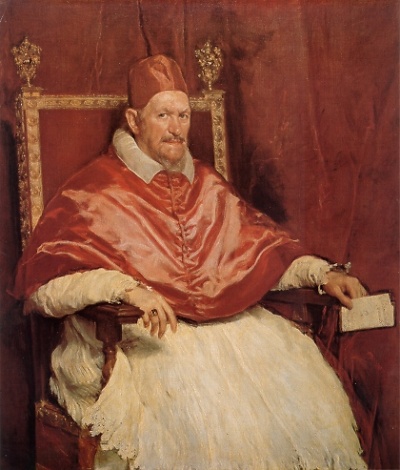
Diego Rodriguez de Silva y Velázquez
(1599-1660)
Pope Innocent X
| A Stylistic Family Tree
Seventeenth Century
VELÁZQUEZ
VAN DYCK HALS
↓
Eighteenth-Nineteenth Century
RAEBURN LAWRENCE
↓
Nineteenth-Twentieth Century
BOLDINI SARGENT ZORN
SOROLLA SEROV ORPEN
Diego Velázquez, 1599-1660
Anthony Van Dyck, 1599-1641
Frans Hals, 1581-1666
•
Henry Raeburn, 1756-1823
Thomas Lawrence, 1769-1830
•
Giovanni Boldini, 1842-1931
John Singer Sargent, 1856-1925
Anders Zorn, 1860-1920
Joaquin Sorolla y Bastida, 1863-1923
Valentin Serov, 1865-1911
William Orpen, 1878-1931
|
 ote
the dates given below of these three artists— they
are almost exactly contemporaries. Working separately
within their own culture and traditions, each artist developed
an extraordinary command of the premier coup technique.
These paintings each are brilliantly realistic in the
lively recreation of a vibrant human persona, yet achieved
with a simple and forthright directness. The paint appears
to have been applied directly to the canvas, and for the
most part left alone, without subsequent overpaintings. ote
the dates given below of these three artists— they
are almost exactly contemporaries. Working separately
within their own culture and traditions, each artist developed
an extraordinary command of the premier coup technique.
These paintings each are brilliantly realistic in the
lively recreation of a vibrant human persona, yet achieved
with a simple and forthright directness. The paint appears
to have been applied directly to the canvas, and for the
most part left alone, without subsequent overpaintings.
|
Frans Hals
(1581-1666)
The Laughing Cavalier |
 |
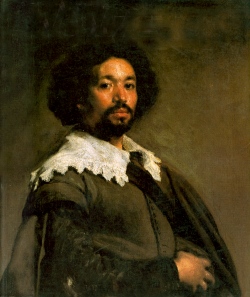 |
Diego Velázquez
(1599-1660)
Juan de Pareja |
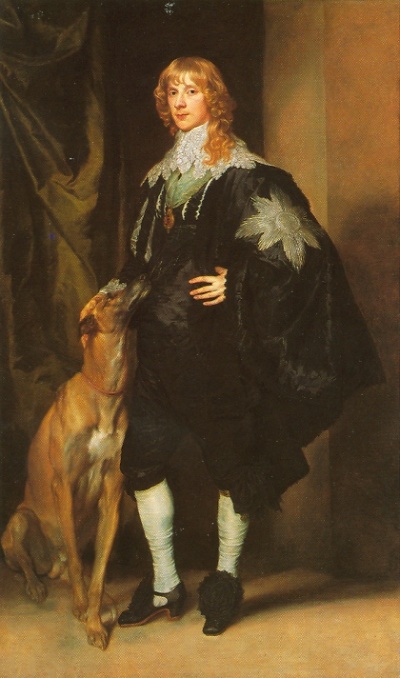
Anthony Van Dyck (1599-1641)
James Stuart, Duke of Richmond and Lenox
ere
are two classic examples of the English portraiture. Raeburn's
preoccupation was with form as revealed by light and shade.
His touch is sure and boldly definite. The image seems
as solid as if it were carved from marble and lit by a
spotlight. The Lawrence is more subtle. Each surface is
rendered with great sensitivity, from the velvet robe
to the delicate modulations in the flesh.
|
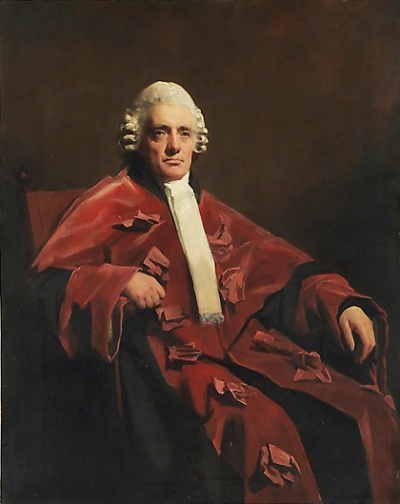
Sir Henry Raeburn (1756-1823)
Lord Robertson

Sir Thomas Lawrence (1769-1830)
John Julius Angerstein
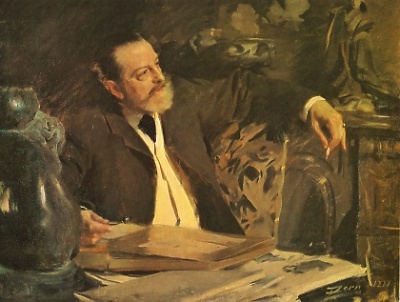
Anders Zorn (1860-1920)
Portrait of Antonin Proust
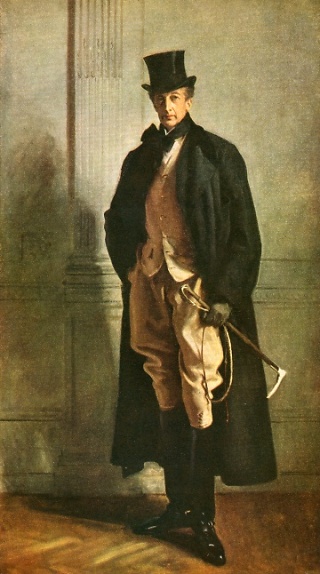
John Singer Sargent (1856-1925)
Lord Ribblesdale
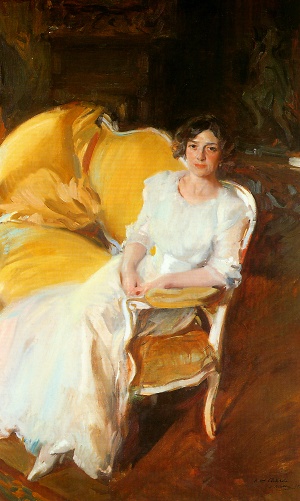
Joaquin Sorolla y Bastida (1863-1923)
Clotilde Seated on the Sofa

Valentin Serov (1865-1911)
Portrait of Nikolai Rimsky-Korsakv

Sir William Orpen (1878-1931)
President Woodrow Wilson |